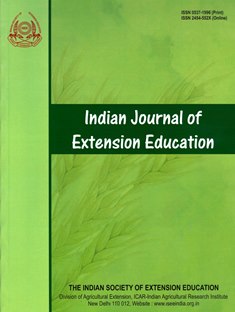Cross-Cultural Comparative Analysis of Technological Gap between Tribal Pineapple Growers of Meghalaya, India
DOI:
https://doi.org/10.48165/IJEE.2023.59133Keywords:
Technological gap, Tribal communities, Pineapple growers, Agro economic, Extension-communication, Socio-psychologicalAbstract
The varied agro-climatic condition of Meghalaya favours cultivation of different horticultural crops, particularly different fruit crops, and pineapple is the most notable of them. The present study was conducted on 200 tribal pineapple growers of Meghalaya in the North Eastern Himalayan region of India in the year 2017-2018. The article highlighted the technological gap among pineapple growers with special emphasis on the differences in agro-economic, socio-psychological and extension-communication characteristics between the Khasi and the Garo tribes of Meghalaya in the north-eastern Himalayan region of India. The average level of the technological gap of Garo farmers (61.78%) was slightly higher than that of Khasi farmers (57.85%). The Mann-Whitney U test reported that the mean scores of the technological gap for the farmers of West Garo Hills and Ri Bhoi were indicating a significant difference in the technological gap between the farmers of these two tribes. The study suggested the need to understand the differential characteristics of these tribes and to introduce location-specific technologies to minimize the technological gap and increase pineapple production in these tribal areas.
Downloads
References
Ashutosh, D., & Basu, D. (2008). Differential training need of guava growers in two agro-climatic zones of West Bengal. Environment and Ecology, 26(4C), 2326-2331.
Biradar, G. S. (2012). A study on Technological Gap in Adoption of Improved Chilli Cultivation Practices in Yadagir and Raichur Districts of Karnataka. Unpublished M. Sc. (Agri.) Thesis, University of Agricultural Science, Raichur.
Das, L., Nain, M. S., Singh, R., & Burman, R. R. (2014). Constraints in marketing of fruits as perceived by the fruit growers and NERAMAC in Assam. Journal of Community Mobilization and Sustainable Development, 9(2), 114-117.
Das, L., Nain, M. S., Singh, R., & Burman, R. R. (2015). Effectiveness of backward and forward linkage in fruit cultivation: A study of NERAMAC. Indian Journal of Extension Education, 51(1&2), 70-74.
Department of Agriculture Meghalaya. (2006). Meghalaya Agriculture Profile 2006.http://megagriculture.gov.in/public/dwd_docs/ MegAgriProfile2006.pdf
Directorate of Economics and Statistics, Government of Meghalaya, Shillong. (2020, September 13). State Level Crop Statistics Report on Kharif Crops.http://megagriculture.gov.in/PUBLIC/ dwd_docs/STATELEVELCROPREPORT2018-192019-20.pdf
ICAR-National Institute of Abiotic Stress Management (2017). A step towards Improving Livelihood of Tribal Farmers Through Integrated Farming. ICAR-NIASM Technical Bulletin - 10 Tribal Sub Plan Programme.
Lahiri, B. (2016). Agricultural information seeking behaviour of Garo tribal farmers of Meghalaya, India. Ecology, Environment and Conservation, 22(June Suppl.), 227-236.
Lahiri, B., & Das, P. (2010). Role of nokma (village headman) in agriculture of West Garo Hills, Meghalaya. Journal of Extension Education, 15(1&2), 72-82.
Marak, B. R., Bandyopadhyay, A., & Lahiri, B. (2015). Adoption of pineapple production technology inWest Garo Hills district of Meghalaya. Indian Research Journal of Extension Education, 15(3), 56-59.
Marak, B. R., Bandyopadhyay, A., Lahiri, B., & Reang, B. (2015). Determination of factors contributing towards adoption of scientific pineapple cultivation in West Garo Hills district of Meghalaya. Ecology Environment and Conservation, 22(June Supplement), S163-S168.
Mathew, B., Pereira, L. S., & Suresh C.P. (2011). Pineapple production in Meghalaya (India) - Indigenous cultural practices and status. Acta Horticulturae, 902, 275-280.
Nongbri, B., Singh, R., Feroze, S. M., Devarani, L., and Hemochandra, L. (2021). Food and Nutritional Security of Farm Households in Meghalaya: A Food Basket Approach Using Temporal and Spatial Analysis. Indian Journal of Agricultural Economics,76(2), 292-306.
Ray, G. L., Chatterjee, P., & Banerjee, S. N. (1995). Technological Gap and Constraints in Agricultural Technology Transfer. Naya Prakash, Calcutta, India.
Roy, D., & Bandyopadhyay, A. K. (2019). Study of technological gaps in pineapple cultivation in Darjeeling district of West Bengal. Indian Journal of Extension Education, 55(1), 16-20.
Roy, P., & Ghosh, S. (2022). Constraints faced by pineapple growers in Tripura. Indian Journal of Extension Education, 58(2), 140- 143. http://doi.org/10.48165/IJEE.2022.58227
Rymbai, D., Singh, R., Feroze, S.M., Rani, P. M. N., Bardoloi, R., & Monika, A. (2012). Pineapple cultivation in Meghalaya and livelihood: An economic analysis. Horticulture for economic prosperity and nutritional security in 21st century, pp 287-299.
Shah, Z. A., Dar, M. A., Dar, E. A., Mir, R., & Ali, M. T. (2022). Technological gap in recommended practices of apple cultivation in Kashmir valley. Indian Journal of Extension Education, 58(2), 158-162.
Singha, K., & Nayak, P. (2015). Reconsidering ethnic-based-autonomy movements in Meghalaya: An analysis. Munich Personal RePEc Archive, pp 1-16.
Downloads
Published
Issue
Section
License

This work is licensed under a Creative Commons Attribution-NonCommercial-NoDerivatives 4.0 International License.

